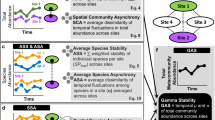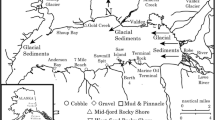Coastal-marine biodiversity conservation must focus increasingly at the level of the land- and seascape. Five cases illustrate discontinuities and synergisms and how system changes may take place. For Caribbean coral reefs, the result of overfishing and disease has been a ‘shrinkage’ in the entire system, the effects of which may cascade through the coastal seascape. For Beringia, patterns of benthic diversity are best understood in a manner that matches the multiscale, integrated dynamics of weather, ice, marine mammal feeding, and community structure. In the case of US East Coast estuaries, oyster reefs may be keystone elements, with important effects on functional diversity. Large-scale coastal systems depend upon the connectivity of fresh and marine waters in the coastal zone, having implications for the apparent stochasticity of coastal fisheries. And, for a coastal barrier-lagoon site, a state change may be described in terms of a combination of succession, the attainment of a quasi-equilibrium state, and disturbance. A profound problem for conservation is that there is very little information about the relationship between species diversity and ecological function. Coastal-marine biodiversity conservation is best addressed at the level of the land- and seascape.
Similar content being viewed by others
References
Angel, M.V. (1991) Biodiversity in the oceans. Ocean Challenge 2, 28–36.
Bahr, L.M. and Lanier, W.P. (1981) The ecology of intertidal oyster reefs of the South Atlantic coast: a community profile. U.S. Fish and Wildlife Service, Office of Biological Services, Washington D.C. FWS/OBS-81/15.
Bartholomew, G.A. (1986) The role of natural history in contemporary biology. BioScience 36, 324–9.
Bell, P.R.F. and Elmetri, I. (1995) Ecological indicators of large-scale eutrophication in the Great Barrier Reef lagoon. Ambio 24, 208–15.
Bormann, F.H. and Likens, G.E. (1979) Pattern and Process in a Forested Ecosystem. New York: Springer-Verlag.
Brown, B.E. and Oggen, J.C. (1993) Coral bleaching. Sc. Amer. 268, 64–70.
Carlton, J.T. and Geller, J.B. (1993) Ecological roulette: the global transport of nonindigenous marine organisms. Science 261, 78–82.
CCEAD (1995) Interim report on pilchard kills in Australian waters. Consultative Committee on Exotic Animal Disease. MS pp. 1–18 plus Attachments. New South Wales Fisheries, Sydney, Australia.
Cooper, S.R. and Brush, G.S. (1991) Long-term history of Chesapeake Bay anoxia. Science 254, 992–6.
Cronon, W. (1983) Change in the Land: Indians, Colonists, and the Ecology of New England. New York: Hill and Wang.
Daly, H.E. and Cobb, J.B.Jr (1989) For the Common Good. Boston: Beacon Press.
Dame, R., Childers, D. and Keopfler, E. (1992) A geohydrologic continuum theory for the spatial and temporal evolution of marsh-estuarine systems. Neth. J. Seas Res. 30, 63–72.
Dayton, P.K. and Tegner, M.J. (1984) The importance of scale in community ecology: a kelp forest example with terrestrial analogs. In A New Ecology: Novel Approaches to Interactive Systems (P.W., Price, C.N., Slobodchikoff and W.S., Gaud, eds) pp. 457–81. New York, John Wiley & Sons.
Dungan, M.L., Miller, T.E. and Thomson, D.A. (1982) Catastrophic decline of a top carnivore in the Gulf of California rocky intertidal zone. Science 216, 989–91.
Dynesius, M. and Nilsson, C. (1994) Fragmentation and flow regulation of river systems in the northern third of the world. Science 266, 753–62.
Fay, F.H. (1982) Ecology and biology of the Pacific Walrus, Odobenus rosmarus Illiger. North Amer. Fauna 74. US Fish & Wildlife Service, Washington, DC.
Fay, F.H., Ray, G.C. and Kibal'chich, A.A. (1984) Time and location of mating and associated behavior of the Pacific walrus, Odobenus rosmarus divergens Illiger In Soviet-American Cooperative Research on Marine Mammals, Vol. 1-Pinnipeds (F.H. Fay and G.A. Fedoseev. eds) pp. 89–99. NOAA Tech. Rept. NMFS 12.
Franklin, J.F. (1993) Preserving biodiversity: species, ecosystems, or landscapes? Ecol. Applic. 3, 202–5.
Gilpin, M.E. (1987) Spatial structure and population viability. In Viable Populations for Conservation (M.E., Soulé, ed.) pp. 125–39. Cambridge: Cambridge University Press.
Gleick, P.H. (1993) Water in Crisis: a Guide to the World's Freshwater Resources, Oxford: Oxford University Press.
Glynn, P.W. (1991) Coral reef bleaching in the 1980s and possible connections with global warming. TREE 6, 175–9.
Gray, J.S. (1982) Eutrophication in the sea. In Marine Eutrophication and Population Dynamics (G., Colombo, I., Ferrari, V.U., Ceccherelli and R., Rossi, eds) pp. 3–15. Fredensborg, Denmark: Olsen and Olsen.
Hallegraeff, G.M. (1993) A review of harmful algal blooms and their apparent global increase. Phycologia 32, 79–99.
Hanski, I. and Gilpin, M. (1991) Metapopulation dynamics: brief history and conceptual domain. Biol. Jour. Linn. Soc. 42, 3–16.
Hayden, B.P., Dueser, R.D., Callahan, J.T. and Shugart, H.H. (1991) Long-term research at the Virginia Coast Reserve. BioScience 41, 310–18.
Hodgson, G. (1994) Coral reef catastrophe. Science 266, 1930–1.
Holligan, P. (1990) Coastal Ocean Fluxes and Resources. Stockholm: IGBP Global Change Rept. No. 14.
Holligans, P. and deBoois, H. (1993) Land-Ocean Interactions in the Coastal Zone (LOICZ). Stockholm: IGBP Global Change Rept. No. 25.
Hughes, T.P. (1994a) Catastrophes, phase shifts, and large-scale degradation of a Caribbean coral reef. Science 265, 1547–51.
Hughes, T.P. (1994b) Coral reef catastrophe: Response. Science 266, 1932–3.
Jackson, J.B.C. (1994) Constancy and change of life in the sea. Phil. Trans. R. Soc. Lond. 344, 55–60.
Klaus, A.D., Oliver, J.S. and Kvitek, R.G. (1990) The effects of gray whale, walrus, and ice-gouging disturbance on benthic communities in the Bering Sea and Chukchi Sea, Alaska. Nat. Geog. Res. 6, 470–84.
Lessios, H.A., Robertson, D.R. and Cubit, J.D. (1984) Spread of Diadema mass mortality through the Caribbean. Science 226, 335–7.
May, R.M. (1977) Thresholds and breakpoints in ecosystems with a multiplicity of stable states. Nature 269, 471–7.
May, R.M. and Southwood, T.R.E. (1990) Introduction. In Living in a Patchy Environment (B., Shorrocks and I.R., Swingland, eds) pp. 1–22. Oxford: Oxford University Press.
Meyer, J.L., Schultz, E.T. and Helfman, G.S. (1983) Fish schools: an asset to corals. Science 220, 1047–9.
Myers, N. (1992) Population/environment linkages: discontinuities ahead. Ambio 21, 116–8.
Myers, N. (1993) Biodiversity and the precautionary principle. Ambio 22, 74–9
Myers, R.A., Barrowman, N.J., Hutchings, J.A. and Rosenberg, A.A. (1995) Population dynamics of exploited fish stocks at low population levels. Science 269, 1106–8.
Nebhan, G.P. (1995) The dangers of reductionism in biodiversity conservation. Cons. Biol. 9, 479–81.
Nelson, C.H. and Johnson, K.R. (1987) Whales and walruses as tillers of the sea floor. Sci. Amer. 256, 112–7.
Newell, R.I.E. (1988) Ecological changes in Chesapeake Bay: are they the result of overharvesting the American Oyster, Crassostrea virginica? In Understanding the Estuary: Advances in Chesapeake Bay Research. Proceedings of a Conference, pp. 536–46. Baltimore, MD: Chesapeake Research Consortion Publ. 129. CBP/TRS 24/88.
Nichols, F.H., Cloern, J.E., Luoma, S.N. and Peterson, D.H. (1986) The modification of an estuary. Science 231, 567–73.
NRC (1995) Understanding Marine Biodiversity: a Research Agenda for the Nation. Committee on Biological Diversity in Marine Systems, National Research Council, Washington, DC: National Academy Press.
Ogden, J.C. (1988) The influence of adjacent systems on the structure and function of coral reefs. Proceedings of the 6th International Coral Reef Symposium 1, 123–9.
Ogden, J.C. (1994) Coral reef catastrophe. Science 266, 1931.
O'Neill, R.V., DeAngelis, D.L., Waide, J.B. and Allen, T.F.H. (1986) A Hierarchical Concept of Ecosystems. Monog. in Pop. Biol. No. 23. Princeton: Princeton University Press.
Orians, G.H. (1975) Diversity, stability and maturity in natural systems. In Unifying Concepts in Ecology (W.H., vanDobben and R.H., Lowe-McConnell, eds) pp. 139–50. The Hague: W. Junk.
Randall, J.E. (1974) The effect of fishes on coral reefs. Proceedings of the Second International Coral Reef Symposium, pp. 159–66. Brisbane: Great Barrier Reef Committee.
Ray, G.C. (1984) Submersible systems for ecological research in polar regions. Mar. Tech Soc. J. 18, 54–60.
Ray, G.C. and Gregg, W.P.Jr (1991) Establishing biosphere reserves for coastal barrier systems. BioScience 41, 301–9.
Ray, G.C. and Hufford, G.L. (1989) Relationships among Beringian marine mammals and sea ice. Rapp. P.-v., Reun. Cons. int. Explor. Mer. 188, 22–39.
Ray, G.C. and McCormick-Ray, M.G. (1992) Functional coastal-marine biodiversity. Trans. 57th Wildl. Nat. Res. Conf, pp. 384–97. Washington: Wildlife Management Institute.
Ray, G.C. and Schevill, W.E. (1974) Feeding of a captive gray whels. Eschrichtius robustus. Mar. Fish. Rev. 36, 31–8.
Ray, G.C. and Wartzok, D. (1974) BESMEX-Bering Sea Marine Mammal Experiment. NASA. Ames Res. Cntr TMX-62,399.
Ray, G.C., Hayden, B.P., McCormick-Ray, M.G. and Smith, T.M. (In press) Land-seascape diversity of the U.S. east coast coastal zone with particular reference to estuaries. In Marine Biodiversity: Causes and Consequences (R.F.G. Ormond and J. Gage, eds). Cambridge: Cambridge University Press.
Sherman, K. and Alexander, L.M. (eds) (1986) Variability and Management of Large Marine Ecosystems. Washington, DC: American Association for the Advancement of Science.
Shugart, H.H. (1990) A Theory of Forest Dynamics: the Ecological Implications of Forest Succession Models. Berlin: Springer-Verlag.
Solbrig, O.T. (ed.) (1991) From Genes to Ecosystems: a Research Agenda for Biodiversity. Rept of a IUBS-SCOPE-UNESCO workshop. Paris, Int'l Union of Biol. Sci.
Steele, J.H. (1989) The ocean ‘landscape’. Landscape Ecol. 3, 186–92.
Steele, J.H. (1991) Marine functional diversity. BioScience 41, 470–4.
Thayer, C.W. (1979) Biological bulldozers and the evolution of marine benthic communities. Science 203, 458–61.
Tilman, D., May, R.M., Lehman, C.L. and Nowak, M.A. (1994) Habitat destruction and the extinction debt. Nature 371, 65–6.
Turner, R.E. and Rabalais, N.N. (1994) Coastal eutrophication near the Mississippi river delta. Nature 368, 619–21.
Author information
Authors and Affiliations
Rights and permissions
About this article
Cite this article
Carleton Ray, G. Coastal-marine discontinuities and synergisms: implications for biodiversity conservation. Biodivers Conserv 5, 1095–1108 (1996). https://doi.org/10.1007/BF00052719
Received:
Revised:
Accepted:
Issue Date:
DOI: https://doi.org/10.1007/BF00052719




